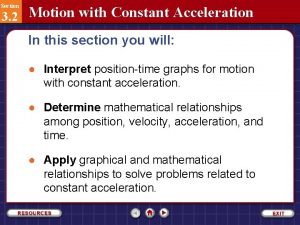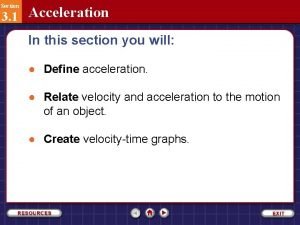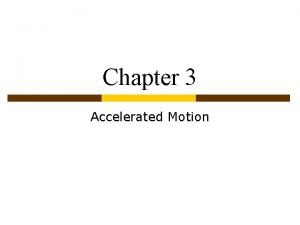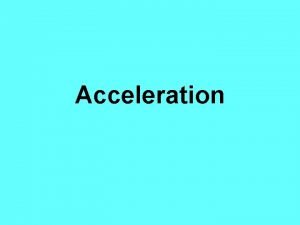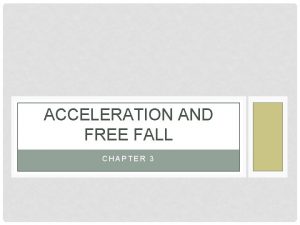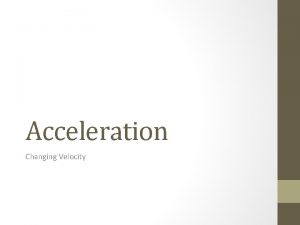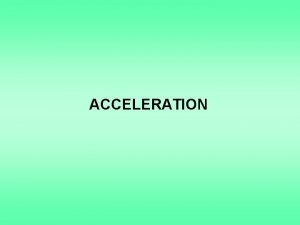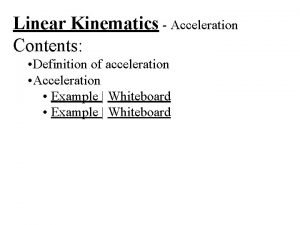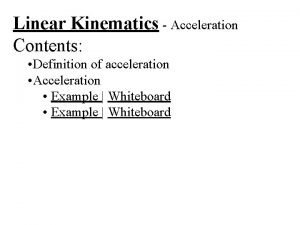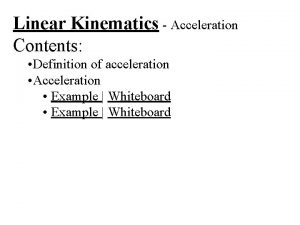Unit 2 Section 2 Notes Acceleration Acceleration v












- Slides: 12

Unit 2 Section 2 Notes Acceleration

Acceleration v Acceleration: rate of change in velocity q An object accelerates if: § It’s speed changes: if an object is speeding up or slowing down, its acceleration is changing § It’s direction changes: if an object is traveling at the same speed but changes direction § Both speed and direction change q Acceleration is a vector quantity: includes both magnitude and direction.

Acceleration v. An object is accelerating even it its speed stays the same and only its direction changes. Why? q Acceleration is defined as the rate at which velocity changes with time; velocity includes both speed and direction, so an object accelerates if its speed, direction, or both change. q Therefore, you can constantly accelerate while never speeding up or slowing down!

Centripetal Acceleration v. Centripetal Acceleration: acceleration that occurs in a circular motion. q If you move at a constant speed in a circle, even though your speed doesn’t change, your direction does; therefore, you are accelerating. § Examples: • • The moon accelerates around the earth Riding on a Ferris wheel Blades on a windmill Roller coaster

Calculating Acceleration To find the acceleration q of an object in a straight line, you need to or measure the object’s velocity at different q times. q To mathematically find acceleration, take the change in an object’s velocity divided by time. q

Acceleration Values v. What do acceleration values tell you? q If acceleration is small, velocity is increasing very gradually. q If acceleration is large, velocity is increasing more rapidly. q Positive acceleration: an object’s velocity is increasing; object is speeding up q Negative acceleration: an object’s velocity is decreasing; object is slowing down

Acceleration Values v. In science, acceleration describes any change in velocity; not just speeding up q When you slow down, you have a negative acceleration because it is opposite the direction of motion.

Graphing Accelerated Motion v. When graphing acceleration: q Independent variable, which is time, is on the x- axis q Dependent variable, which is speed/velocity, is on the y-axis

Graphing Accelerated Motion v A straight line on a speed vs. time graph means the speed changes by the same amount over equal time intervals. This is called constant acceleration. v The slope of a straight line on a speed vs. time graph is equal to acceleration. Line with a positive slope: object is speeding up q Line with a negative slope: object is slowing down q v A curved line on a distance vs. time graph means the object is accelerating.

Acceleration Sample Problems v. Natalie accelerates her skateboard along a straight path from rest to 4. 5 m/s in 2. 5 seconds. Find her average acceleration.

Acceleration Sample Problems v. Find the average acceleration of a northbound subway train that slows down from 12 m/s to 9. 6 m/s in 8 s.

• http: //www. physicsclassroom. com/Class/1 DKi n/U 1 L 1 e. cfm
 Centripetal acceleration ac=
Centripetal acceleration ac= Angular vs linear velocity
Angular vs linear velocity Is radial acceleration the same as centripetal acceleration
Is radial acceleration the same as centripetal acceleration Angular acceleration and linear acceleration
Angular acceleration and linear acceleration Centripetal acceleration tangential acceleration
Centripetal acceleration tangential acceleration Acceleration doodle notes
Acceleration doodle notes What is acceleration
What is acceleration Unit 10, unit 10 review tests, unit 10 general test
Unit 10, unit 10 review tests, unit 10 general test Conversion notes brutes en notes standard wisc 5
Conversion notes brutes en notes standard wisc 5 Motion section 3 acceleration
Motion section 3 acceleration Chapter 11 motion section 2 acceleration answer key
Chapter 11 motion section 2 acceleration answer key What does a negative acceleration indicate
What does a negative acceleration indicate Motion section 3 acceleration
Motion section 3 acceleration









